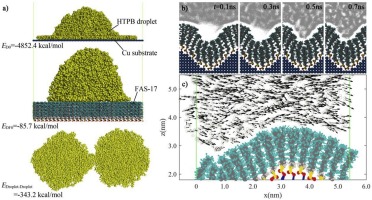当前位置:
X-MOL 学术
›
Prog. Org. Coat.
›
论文详情
Our official English website, www.x-mol.net, welcomes your
feedback! (Note: you will need to create a separate account there.)
Molecular investigations on the adsorption and flow behavior of hydroxyl-terminated polybutadiene (HTPB) binders on Cu surfaces: The effects of surface nanostructure and perfluorosilylation
Progress in Organic Coatings ( IF 6.5 ) Pub Date : 2020-05-01 , DOI: 10.1016/j.porgcoat.2020.105575 Ting Zheng , Chunya Wu , Qing Zhu , Shangbin Li
Progress in Organic Coatings ( IF 6.5 ) Pub Date : 2020-05-01 , DOI: 10.1016/j.porgcoat.2020.105575 Ting Zheng , Chunya Wu , Qing Zhu , Shangbin Li

|
Abstract The flow behavior of highly viscous casting explosives in micro-channels and special shaped moulds are critical factors affecting the formations of solid propellants and explosives. In the present work, the spreading property and flow behavior of hydroxyl-terminated polybutadiene (HTPB) binders, a major component of casting explosives, on Cu surfaces with nanostructures and perfluorosilylation were investigated by classical molecular dynamics simulations. Our results suggest that the atomic steps, exposed on the pit-/terrace-structured Cu surfaces, seem able to restrict the spreading of HTPB molecules from crossing over the step edges. After surface perfluorosilylation, the adhesive strength between HTPB and Cu substrate has decreased by nearly two orders of magnitude, resulting a vigorous travel of single HTPB molecules. Moreover, the cohesive strength between two adjacent HTPB droplets (-343.2 kcal/mol) is found to be higher than the adhesive strength of HTPB droplets on the perfluorosilylated smooth Cu surface (−85.7 kcal/mol). Thus, HTPB droplets could spread slowly on the perfluorosilylated Cu surface with a semi-spherical shape, irrespective of the presence of surface diatomic terraces. The reduced adsorption strength could also result in a slower infiltration speed of HTPB into the perfluorosilylated grooves and an increased slip performance on the perfluorosilylated surfaces.
中文翻译:

端羟基聚丁二烯 (HTPB) 粘合剂在 Cu 表面的吸附和流动行为的分子研究:表面纳米结构和全氟硅烷化的影响
摘要 高黏度铸造炸药在微通道和异型模具中的流动行为是影响固体推进剂和炸药形成的关键因素。在目前的工作中,通过经典分子动力学模拟研究了端羟基聚丁二烯 (HTPB) 粘合剂(铸造炸药的主要成分)在具有纳米结构和全氟硅烷化的 Cu 表面上的铺展性能和流动行为。我们的结果表明,暴露在凹坑/平台结构的铜表面上的原子台阶似乎能够限制 HTPB 分子越过台阶边缘的扩散。表面全氟硅烷化后,HTPB与Cu基板之间的粘合强度降低了近两个数量级,导致单个HTPB分子剧烈运动。而且,发现两个相邻 HTPB 液滴之间的内聚强度 (-343.2 kcal/mol) 高于 HTPB 液滴在全氟硅烷化光滑 Cu 表面上的粘附强度 (-85.7 kcal/mol)。因此,HTPB 液滴可以在半球形的全氟硅烷化 Cu 表面上缓慢扩散,而与表面双原子阶地的存在无关。吸附强度降低还可能导致 HTPB 渗入全氟硅烷化凹槽的速度变慢,并提高全氟硅烷化表面的滑动性能。HTPB 液滴可以在半球形的全氟硅烷化 Cu 表面上缓慢扩散,而与表面双原子阶地的存在无关。吸附强度降低还可能导致 HTPB 渗入全氟硅烷化凹槽的速度变慢,并提高全氟硅烷化表面的滑动性能。HTPB 液滴可以在半球形的全氟硅烷化 Cu 表面上缓慢扩散,而与表面双原子阶地的存在无关。吸附强度降低还可能导致 HTPB 渗入全氟硅烷化凹槽的速度变慢,并提高全氟硅烷化表面的滑动性能。
更新日期:2020-05-01
中文翻译:

端羟基聚丁二烯 (HTPB) 粘合剂在 Cu 表面的吸附和流动行为的分子研究:表面纳米结构和全氟硅烷化的影响
摘要 高黏度铸造炸药在微通道和异型模具中的流动行为是影响固体推进剂和炸药形成的关键因素。在目前的工作中,通过经典分子动力学模拟研究了端羟基聚丁二烯 (HTPB) 粘合剂(铸造炸药的主要成分)在具有纳米结构和全氟硅烷化的 Cu 表面上的铺展性能和流动行为。我们的结果表明,暴露在凹坑/平台结构的铜表面上的原子台阶似乎能够限制 HTPB 分子越过台阶边缘的扩散。表面全氟硅烷化后,HTPB与Cu基板之间的粘合强度降低了近两个数量级,导致单个HTPB分子剧烈运动。而且,发现两个相邻 HTPB 液滴之间的内聚强度 (-343.2 kcal/mol) 高于 HTPB 液滴在全氟硅烷化光滑 Cu 表面上的粘附强度 (-85.7 kcal/mol)。因此,HTPB 液滴可以在半球形的全氟硅烷化 Cu 表面上缓慢扩散,而与表面双原子阶地的存在无关。吸附强度降低还可能导致 HTPB 渗入全氟硅烷化凹槽的速度变慢,并提高全氟硅烷化表面的滑动性能。HTPB 液滴可以在半球形的全氟硅烷化 Cu 表面上缓慢扩散,而与表面双原子阶地的存在无关。吸附强度降低还可能导致 HTPB 渗入全氟硅烷化凹槽的速度变慢,并提高全氟硅烷化表面的滑动性能。HTPB 液滴可以在半球形的全氟硅烷化 Cu 表面上缓慢扩散,而与表面双原子阶地的存在无关。吸附强度降低还可能导致 HTPB 渗入全氟硅烷化凹槽的速度变慢,并提高全氟硅烷化表面的滑动性能。










































 京公网安备 11010802027423号
京公网安备 11010802027423号